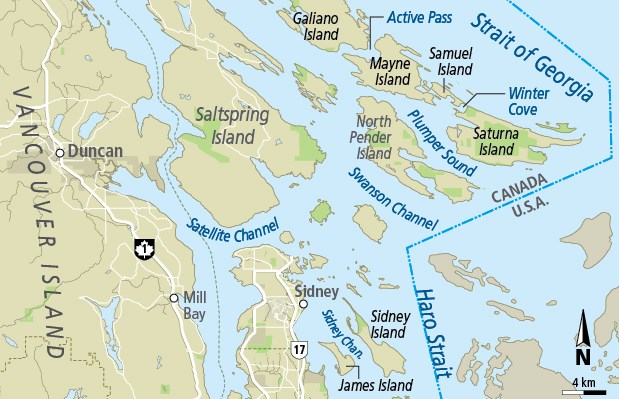Invasive deer with voracious appetites are swimming between Gulf Islands and, as native trees and plants are munched out of existence, Parks Canada and local residents are looking for a final solution.
European fallow deer — a different species from the native black-tailed deer — were introduced to James Island for sport hunting at the turn of the century.
The population then spread to Sidney Island, where, for the past four years, the Sallas Forest Strata Corp. — made up of island property owners — and Parks Canada have collaborated on an annual cull. Using a corral system, bolt guns and a mobile meat processor, they’ve reduced the population from about 2,000 to 300.
However, the fallow deer population on Mayne Island, which ballooned after an escape from a deer farm two decades ago, is continuing to grow despite a licensed hunter program. Some of the animals have now island-hopped to Saturna.
“We don’t know how many swam from Mayne to Samuel Island and, from there, they have made it to Winter Cove on Saturna,” said Todd Shannon, acting superintendent of Gulf Islands National Park Reserve.
Sightings have also been reported on Galiano Island.
The deer can cover more than 1.5 kilometres in their island-hopping expeditions.
“They are not discriminating about what vegetation they eat. They strip everything, and they’re very adaptive and outcompete the native blacktail species,” Shannon said.
The fallow deer pose a threat to the rare Garry oak ecosystem, as well as vineyards and gardens, so cameras are being set up on Saturna to figure out deer numbers. Parks Canada will then ask for community input on the next move, Shannon said.
“Ideally, the best solution would be to try to remove all the animals. That’s where the conversation is now,” he said.
“We’ll be talking to experts over the next year and then building a longer-term plan.”
Kate Emmings, Islands Trust ecosystem protection analyst, agrees eradication is probably the way to go.
“These are not a native species, there’s a lack of predators, and they have multiple young,” she said.
It appears fallow deer are swimming to new islands when they exhaust their existing food source, Emmings said.
“They see nice bushes on other islands and swim over,” she said.
While the Sidney and Saturna populations could be relatively easy to eradicate, it could prove more difficult on Mayne.
It is believed there are at least 500 animals on the island. The population is continuing to grow even though licensed hunters take 100 to 150 a year, said David Maude of the Mayne Deer Committee.
“They are severely affecting the ecosystem, and I think the only way to deal with them properly is to exterminate them, but the province has never really taken ownership of the issue,” he said.
Lack of predators means the black-tailed deer population is also growing on Mayne, Maude said.
“We have said we don’t want cougars and wolves and bears in our backyard and then people wonder where all the deer are coming from,” he said.
Michael Dunn, Mayne Island Conservancy president, said the deer are particularly hard on arbutus, Garry oaks and conifers such as western red cedar.
The group is looking for funding to help them establish the density of deer, especially as many of the animals are moving into more developed areas, where they cannot be shot, he said.
“People are getting really frustrated,” he said. “We need to bite the bullet.”
However, a complete cull is controversial, and there are many on Mayne Island who would not agree with it, Dunn said.



